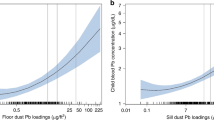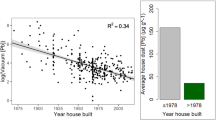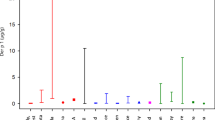Abstract
Objectives: The purpose of the study was to evaluate the magnitude of environmental lead contamination in the downtown area of Miami. Methods: Lead inspections took place at 121 homes in Little Haiti and Liberty City and involved the collection of representative samples from floors, window wells, tap water, soil and air. Community health workers (CHWs) trained in interview and safety techniques went from door to door to enlist participation. On-site investigations were tailored to areas most utilized by children under the age of 6 years. The presence of lead-containing paint was also investigated in situ via X-ray fluorescence (XRF) analysis. Results: Of the sampling areas, the window wells area had the most abundant occurrence of lead. On analysis, 24% of sites returned window well samples with lead levels above Department of Housing and Urban Development (HUD) guidelines. Of the soil samples, the playgrounds around the house had the highest concentration of lead. Soil sampling demonstrated that 27.5% of sites returned samples with lead levels (400 to 1600 ppm) in excess of HUD/Environmental Protection Agency (EPA) standards. Positive XRF readings in one or more components were returned by 18% of sites. Conclusions: More than half of the houses in these two neighborhoods exhibited unacceptably high levels of lead dust and soil in areas where children live and play. Limitations of this study did not allow the assessment of how many children in this area are affected. A more comprehensive study including other areas of Miami-Dade County with older housing stock is recommended.
This is a preview of subscription content, access via your institution
Access options
Subscribe to this journal
Receive 6 print issues and online access
$259.00 per year
only $43.17 per issue
Buy this article
- Purchase on Springer Link
- Instant access to full article PDF
Prices may be subject to local taxes which are calculated during checkout








Similar content being viewed by others
Abbreviations
- MDCHD:
-
Miami-Dade County Health Department
- XRF:
-
X-ray fluorescence
- HUD:
-
Housing and Urban Development
- EPA:
-
Environmental Protection Agency
- CLPP:
-
Childhood Lead Poisoning Prevention
- FIU:
-
Florida International University
- WHO:
-
World Health Organization
- CHW:
-
community health worker
- μg/dl:
-
micrograms per deciliter
- μg/m3:
-
micrograms per cubic meter
- ppm:
-
parts per million
- ppb:
-
parts per billion
- μg/ft2:
-
micrograms per square foot
References
CACI Sourcebook America, 1997 edition. CACI Marketing Systems, Arlington, VA 1997
Hopkins RS Quimba R Watkins SM Elevated blood lead prevalence in Florida two-year olds, J Fla Med Assoc (1995) 82: 193–197
Lanphear BP Dietrich K Auinger P Cox C Cognitive deficits associated with blood lead concentration <10 μg/dl in US children and adolescents, Public Health Rep (November/December 2000) 115(6): 521–529
Miami-Dade County Health Department (MDCHD) 1998 Annual Report. MDCHD, Miami, FL 1999
National Research Council Measuring Lead Exposures in Infants, Children, and Other Sensitive Populations. National Academy Press, Washington, DC 1993
World Health Organization and UNICEF Primary Health Care. Geneva, Switzerland, WHO 1978
Acknowledgements
Three institutions were involved in the study: Florida International University (FIU) Department of Public Health staff were responsible for overall study design and implementation, field operations, data analysis, and reporting; Ambient Environmental — responsible for environmental lead investigations including sampling and analyzing environmental samples; Miami-Dade Resident College (Consultants) — provided assistance in hiring two community health workers and their supervisor who helped in the community outreach activities of the project through locating and setting up an appointment with the parents/guardians who had a child under 6 years of age and who were willing to participate in the study. The personnel of the project wish to thank Florence Bayuk Foundation, which awarded a graduate fellowship in health sciences to Dr. Mohammed Imana, a graduate assistant in the Department of Public Health; the Dean of the College of Health and Urban Affairs; the Vice President for Research and Graduate Studies; and the Chairperson of the Department of Public Health and the faculty of the same department for securing the respective funds that made possible this pilot study and for their support and assistance all the way until the end of this project. We are very grateful to the many graduate students in the Department of Public Health at FIU who helped in the data collection phase of this research. We thank all the residents who allowed us to enter their homes to do sampling.
Author information
Authors and Affiliations
Corresponding author
Rights and permissions
About this article
Cite this article
GASANA, J., CHAMORRO, A. Environmental lead contamination in Miami inner-city area. J Expo Sci Environ Epidemiol 12, 265–272 (2002). https://doi.org/10.1038/sj.jea.7500227
Received:
Published:
Issue Date:
DOI: https://doi.org/10.1038/sj.jea.7500227
Keywords
This article is cited by
-
Trends in Racial and Ethnic Disparities in Childhood Asthma in Miami, Florida: 2005–2013
Journal of Immigrant and Minority Health (2018)
-
Alteration in plasma corticosterone levels following long term oral administration of lead produces depression like symptoms in rats
Metabolic Brain Disease (2013)



